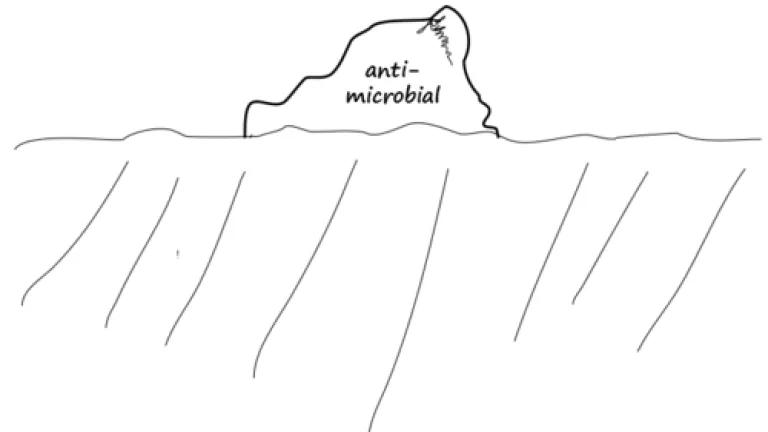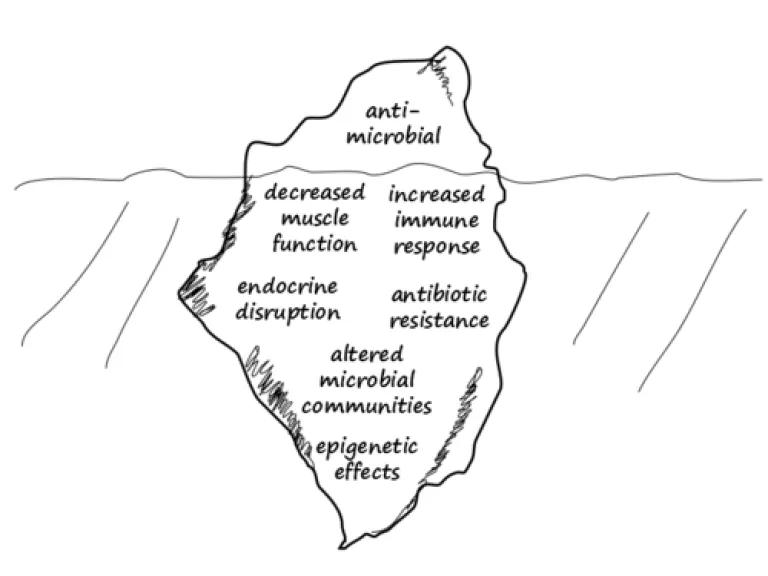
I have always had what one might call a love/hate relationship with bacteria. On the one hand, bacteria can be really scary. No one invites Yersinia pestis (AKA the plague) over for a play date. On the other hand, there are bacteria that can be your BFF.
More lactobacillus with your frozen yogurt? Yes, please!
The complex interaction I have with bacteria is amusing to my friends and family,
Can I borrow your pen, Kristi? Only if you can prove to me that your hands are clean.
and makes studying a complicated chemical like triclosan really exciting.
Triclosan, an antimicrobial chemical, can be found in a variety of household items, including toothpaste, cutting boards, and antibacterial clothing. It is also widely used in antibacterial cleaning products like hand soaps.
Not only is triclosan around us, you can also find it IN us. Children, pregnant moms, everyday people like you and me – triclosan is found in the urine of the majority of people sampled for it. The benefit of playing a starring role in the billion-dollar anti-bacterial hand soap industry is that triclosan ends up everywhere. The down side, though, particularly when triclosan has not been proven safe or effective, is that it can cause a lot of trouble for humans and our environment.
When triclosan appeared in its first FDA monograph in 1978 (see Mae Wu’s blog for the legal perspective), there was very little scientific information available about the chemical. We knew that triclosan had antimicrobial properties, but we didn’t know much about what other properties it might have, including potential toxicity to people and wildlife. With such a huge knowledge gap, FDA correctly determined that triclosan had not been proven either safe for people or effective at preventing illness, and must be removed from consumer products within two years of the monograph being finalized.
Amazingly, over 30 years later, FDA has still not finalized a monograph for triclosan, which has allowed it to remain on store shelves, in our homes, and in our bodies. More than 30 years of FDA inaction has also revealed that antimicrobial properties really were just the tip of the triclosan iceberg.
When triclosan kills or slows down bacteria, it doesn’t specifically target the ones we don’t want. It can also kill the ones we do want. Emerging research on the human microbiome (the microbial communities that live in and on us and help us with essential processes like digestion) has shown us that triclosan could harm the beneficial bacteria in our gut (Lankester, 2013), and could help a potentially harmful bacteria, Staphylococcus aureus, make a cozier home in our noses (Syed, 2014).
Triclosan doesn’t limit itself to bacteria, though. It also has the ability to alter normal functions in larger organisms. Triclosan has been shown to disrupt muscle function in minnows and rats (Cherednichenko, 2012), has caused a heightened allergic response in mice (Anderson, 2013), and has reduced reproductive capacity in mice (Crawford, 2012), rats (Lan, 2014), and sea urchins (Hwang, 2014).
In humans, triclosan has been associated with asthma exacerbation in asthmatics (Savage, 2014), altered thyroid hormone production (Koeppe, 2013) (see Dr. Maricel Mafini’s blog for an overview of the thyroid), and increased weight gain (Lankester, 2013). On top of all these things, triclosan can behave like estrogen (Huang, 2014), potentially make changes to our epigenome (little signs that help tell our genome where, when, and what to do) (Ma, 2013), and increase antibiotic resistance in some bacteria (Middleton, 2013). The triclosan iceberg is surprisingly large, made even more troubling by its widespread use and evidence that when used to wash your hands…

It is no more effective at reducing illness than plain soap and water.
So, while triclosan is a great chemical to study for a person that considers bacteria to be both friend and foe, when I tell my sister to her wash her hands before using my pen, I also add:
And make sure there’s no triclosan in the soap.
